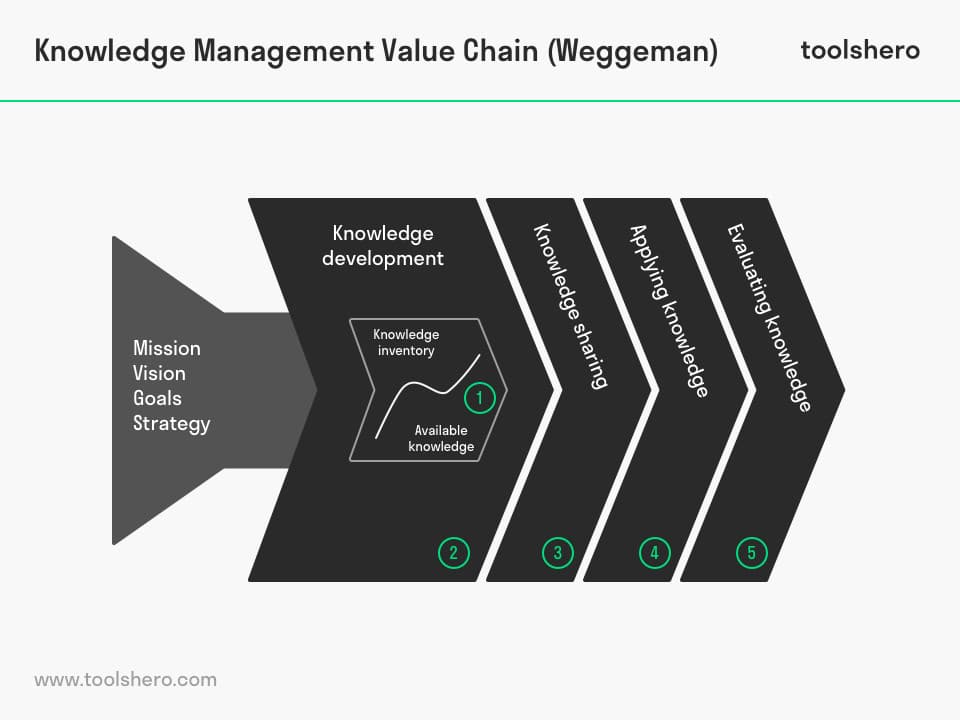Knowledge Management Value Chain

Knowledge Management Value Chain: this article explains the Knowledge Management Value Chain, developed by Mathieu Weggeman in a practical way. After reading you will understand the basics of this powerful knowledge management tool.
What is knowledge management?
Knowledge management focuses on the structured development, transfer, dissemination and application of knowledge within an organization. Knowledge is treated as a production factor in this article. Mathieu Weggeman has developed the Knowledge Management Value Chain model for the management of knowledge in an organization.
Knowledge Management Value Chain
In this model the value of knowledge increases as the knowledge moves from 1 to 5 in the model (to the right). In the Knowledge Management Value Chain (KMVC), an organization must organize and manage the various processes in the KMVC in such a way that the efficiency of the production factor knowledge will be increased as a consequence.
In addition to the traditional production factors such as nature, labour and capital, Mathieu Weggeman also distinguishes knowledge as a production factor. By using all of these production factors jointly, an organization will have a tactical tool to achieve its strategic objectives.
His model consists of five main processes, namely:
Knowledge Inventory
Using strategic objectives, an organization determines what specific knowledge is required to achieve these objectives. A distinction is made between available knowledge and knowledge that needs to be developed. What (technical) skills are needed and what attitude (culture) should be present in the organization? The needed knowledge is then compared with the available knowledge so that the ‘knowledge gap’ is made clear.
Knowledge development
The knowledge gap is used to identify what knowledge development is needed in the organization. This could be done in different ways: from training staff to purchasing knowledge from a third party.
Knowledge sharing
After knowledge has been developed, it needs to be shared within the organization so that everyone can benefit from this and that a superb knowledge value is created. The most ideal situation would be one in which knowledge becomes an integral part of an organization’s strategy and culture.
Applying knowledge
By applying knowledge, it will be integrated in the organization. A mere implementation of knowledge does not suffice. People should familiarize themselves with the available information, experiences and skills. Only then it will be possible to share knowledge within an organization.
Evaluating knowledge
Evaluation is a continuous process and begins in the first stage. This enables knowledge development and possible adjustments.
Knowledge Management Value Chain model : most effective
This model is most effective when the model is used at an organizational level. Of course, it is possible to use the model at department level and/or operational level.
However, it is important that the strategic objectives of the organization are always observed. This is how the knowledge management value chain can make a valuable contribution to the achievement of strategic objectives and as a result will the investment be recouped.
It’s Your Turn
What do you think? Is the Knowledge Management Value Chain model applicable in today’s modern companies? Do you recognize the practical explanation or do you have more additions? What are your success factors for good Knowledge Management within an organization?
Share your experience and knowledge in the comments box below.
More information
- Berends, J.J., Garud, R., Debackere, K. & Weggeman, M.C.D.P. (2011). Thinking along : a process for tapping into knowledge across boundaries. International Journal of Technology Management, 53(1), 69-88.
- Song, Michael, Berends, J.J., Bij, J.D. van der & Weggeman, M.C.D.P. (2007). The effect of IT and co-location on knowledge dissemination. Journal of Product Innovation Management, 24(1), 52-68.
How to cite this article:
Van Vliet, V. (2011). Knowledge Management Value Chain. Retrieved [insert date] from Toolshero: https://www.toolshero.com/management/knowledge-management-value-chain/
Published on: 06/11/2011 | Last update: 03/25/2022
Add a link to this page on your website:
<a href=”https://www.toolshero.com/management/knowledge-management-value-chain/”>Toolshero: Knowledge Management Value Chain</a>







